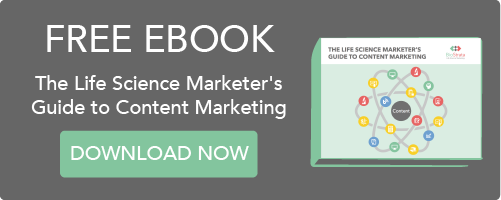
In a previous blog, we discussed how to get your manager’s buy-in on developing and executing a content marketing strategy. But how do you actually present it to your manager, the rest of the marketing team and maybe even C-level executives? We appreciate that this could be a daunting challenge, so in this blog, we’ll outline how to put together a persuasive and widely applicable content strategy presentation to wow your colleagues with.
Include statistics and benchmark data.
Nothing is more persuasive than a strong argument backed up with facts, statistics and benchmark data. As such, make sure to structure your presentation around a few solid facts that add legitimacy to your suggested need for content marketing and to help create a sense of urgency. For instance, you could point out that over 200 million people now use ad blockers (which is fast rendering outbound advertising tactics like banner ads somewhat obsolete), or that content marketing conversion rates are six times higher than those of other marketing strategies. Here’s a great list of content marketing stats to get you started.
Don’t hold back on the gritty details.
Always give extensive details about your plan, as even the most unnerving facts and figures will be useless without a compressive understanding of how your proposed content strategy should be carried out. Include strategic information like the buyer personas you will target, how you will capture their interest and possible content and title idea to achieve this. Also consider the logistics of how you are going to implement the strategy on both macro and micro levels. One last thing that we’ve seen work well in the past is to conduct a competitor content analysis – you can use the results to help create a sense of urgency (i.e. your competitors are getting ahead of you) and to start to highlight how content marketing could be effective in your industry.
Cater to your audience.
It’s important to acknowledge that different people in your organisation will want to focus on different parts of your proposed content marketing strategy. Your manager and C-suite will want to know about budgetary needs and expected ROI, while you marketing team will likely care more for info on strategic execution and content production. The degree to which they’re familiar with the concept will also be highly variable. As such, make sure that you personalise the presentation to cater to your specific audience. Educate enough to warrant their attention, but not enough to bore them or appear condescending. If you’re unsure about where they stand on content marketing before you approach them, try to find out a little about their level of knowledge through a brief survey or question and answers session before putting your presentation together.
Relate everything back to business goals.
While largely included in the previous tip, this is important enough to warrant a section of its own. When push comes to shove, every business activity that uses resources needs to relate back to – and drive progress towards – business goals. As mentioned, there are plenty of stats out there showing how content marketing can demonstrate ROI and increase revenue. But if the effects of your content marketing strategyare expected to go beyond sales and marketing, these should be included in your presentation. For example, content marketing can increase brand awareness, demonstrate industry-wide thought leadership, lower the cost of customer acquisition and increase the likelihood of customer retention. If these goals are likely to be of interest to your audience, put together a compelling argument as to why content marketing can also help you hit these too.
Most importantly, have a great strategy to present!
Whatever you do, don’t go into any presentation underprepared. This will not only make it harder to convince the content marketing sceptics – it’ll reflect badly on you. Make sure everything is planned out and well structured, and that you’re comfortable discussing sections that you’re not including in the presentation. That way, if someone asks a difficult question, you can answer them confidently and avoid the dreaded “I’m not sure, I’ll get back to you”. Remember, excitement is contagious. If you’re confident and excited about what you have to say, your audience will be too.
For more information on putting together an effective content marketing strategy in the life science sector, click here to download our ebook, “A Life Science Marketer's Guide to Content Marketing.”




